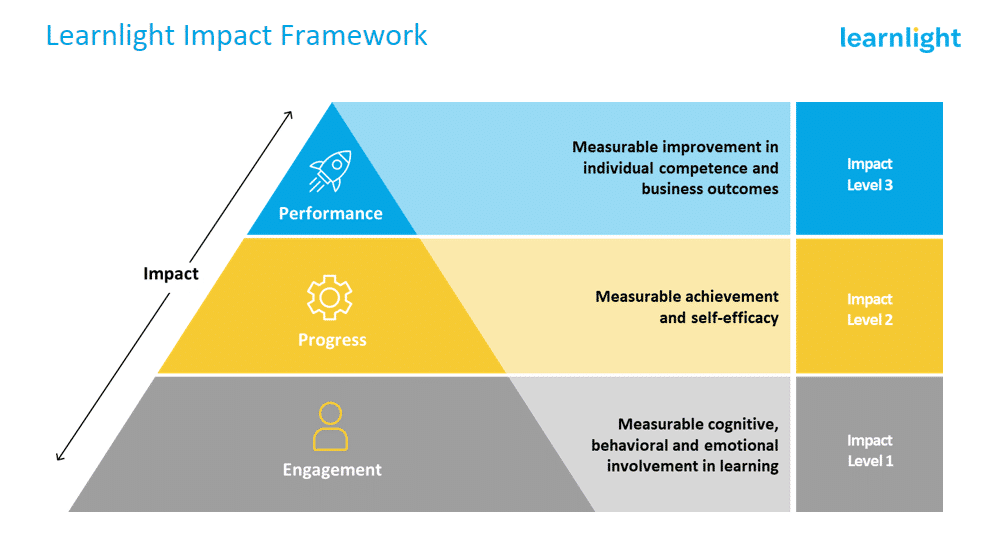In celebrating Learnlight’s 16th anniversary, our thoughts gravitate toward global coming-of-age traditions. Much like these transition periods in life, which can determine whether we bond through appreciation of our cultural differences or drift apart, modern businesses face challenges bridging language, cultural, and interpersonal differences. With our increasing focus on Diversity, Equity, and Inclusion, we must empower employees to collaborate better.
Addressing this requires training which, no surprise – is costly! Businesses face pressure to prove the impact of their training on the business bottom line. While traditional metrics such as completion rates, participation rates and satisfaction scores help keep track of progress, they lack an emphasis on skills application.
As part of our 16-year anniversary, we are revealing our science-backed approach to making the impact of traditional metrics and skills application come together: our Learnlight Impact Framework.
Let’s dive straight in.
When it comes to Learning and Development (L&D), business leaders are constantly seeking ways to enhance employee engagement – during program launches, but also thereafter to guarantee the success of their programs. Research suggests it’s a complex exercise because engagement is made up of a composite of factors:
- Quality and relevance of the training (e.g., Can learners learn anytime, anywhere?)
- Supplementary materials provided (e.g., Are the materials provided helpful?)
- Overall professionalism (e.g., Do trainers cancel sessions at the last minute?)
- Team dynamics (e.g., Can trainers lead group sessions effectively?)
These factors, and their corresponding metrics (completion rates, satisfaction rates, session attendance, etc.), influence learner engagement at three different levels: cognitive – the learner’s effort invested in one’s activities and appreciation of challenges, behavioral – the learners’ involvement and attendance, and emotional – the positive reactions that come with it, for example a sense of belonging.
In this first stage of impact measurement, business leaders learn to understand: (1) What they should be seeking for when selecting a learning partner – because of how this can ‘hook’ employees in the learning experience and build a habit of learning (2) The metrics that help monitor progress in this experience.
At Learnlight we designed our next-level, award-winning platform using our trademarked methodology (the Learnlight Empowerment Method™), to ensure these engagement markers are factored into the learner experience, boosting engagement levels as a result.
When learners are engaged and working hard to learn new concepts, a business’ immediate reaction may be – “finally the benefits are coming our way!.” Leaders want to understand how far their learners are in their learning journey, their pace of learning, and their scores. They focus on achievement.
However, achievement is only one part of the observable metrics of learning progress. This is especially so given that certain skills require more explanation, whilst others require more active practice. In the case of communication, they entail a complex mix of both. They also require an ability to judge when and why to apply such knowledge.
Learners need time and a safe space to practice before reaping the achievements. Failing to acknowledge progress beyond achievement risks businesses creating a performance-obsessed culture focused on quantity versus quality, meaning other important factors of progress get overlooked.
We encourage leaders to consider achievement in combination with self-efficacy (i.e. the self-confidence that ‘you can do it’). Developing a more ‘deliberately developmental’ workplace culture is directly linked to this and healthy communication practices can emerge as a result:
- Psychological safety: Role modelling vulnerability and taking personal responsibility for our shortcomings.
- Growth mindset: Continuous learning through enquiry, curiosity and transparency, instead of judgement.
- Controlled testing: Time-limited, manageable experiments, to challenge our unconscious assumptions.
- Open communication: Across the organization, grounded in a shared commitment to be better.
At Learnlight we commit to offering support in nurturing these principles through our contextualized learning practices:
- Trainer-led sessions where learners can bring their work tasks (psychological safety).
- Short, captivating activities with immediate feedback, as well as the opportunity for learners to rate activities and trainer sessions (open communication).
- Low-risk, scenario-based practice in both 1:1 and group formats through instructor-led sessions, and platform features like the Learnlight Café. (controlled testing).
Finally, and perhaps the crux of the matter when measuring impact: performance outcomes.
When implementing learning programs, the hope is that learner progress eventually translates into measurable improvements. This requires learners to go from a conscious application of the skills taught, to an unconscious one – where learners embody the skills naturally. This enables learners to intentionally use their knowledge, impacting business and individual goals.
A few things can help with the transition from conscious to unconscious skills application. Firstly, ensuring training is corporate-specific. Evidence shows when learning happens in the flow of work it’s 2.6x more likely to make employees exceed financial targets. Contextualized training materials and trainer sessions in a workplace culture that rewards more than just achievement, helps employees embrace these skills.
“Learnlight doesn’t just focus on delivering quality learning but on providing the setup for sustained growth, nurturing safe spaces to make mistakes and promoting self-growth”.
Natalia Jaszczuk, Head of Product at Learnlight
Secondly, engaging managers in the journey is key. Our Learnlight Impact Framework encourages a healthy co-creation of intended goals with client managers in advance of launching programs. This becomes our joint reference point to check in on progress, discuss blockers, and accommodate to needs. Performance that’s led and tracked in this way enables Learnlight to become a strong partner to clients, pointing them towards the right resources.
A Culture of Continuous Learning
L&D is much more than providing training for employee engagement, it’s about building a culture of continuous learning that encourages employees to explore, experiment and reach mastery together. It’s not always plain sailing but a few things can help. Find out how to turn your communication training programs into tangible business outcomes with Learnlight today.




































